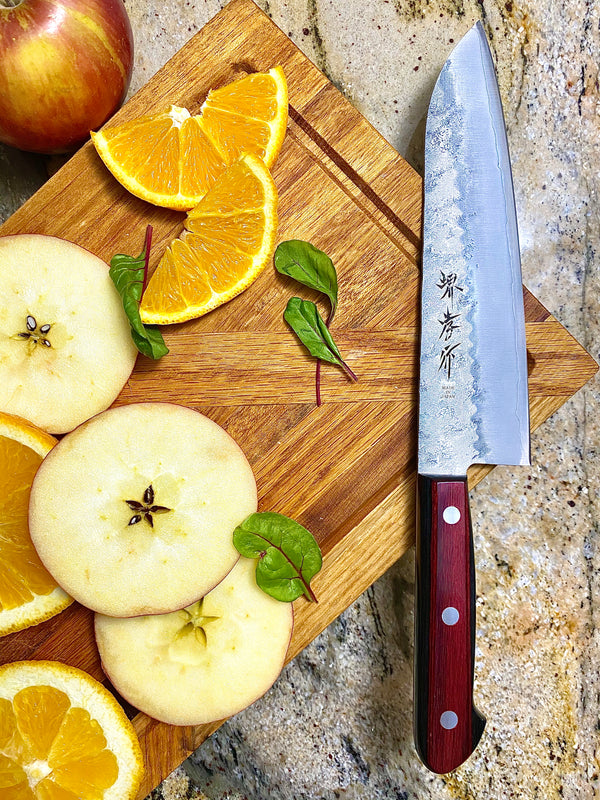Your Cart is Empty
A Sujihiki practically glides through meat due to its narrow width and short height, allowing for less surface area and less friction when slicing. Typically, a Japanese chef would use a Sujihiki to slice through delicate fish in a single, clean stroke and end up with the perfect cut of sashimi. This technique helps preserve flavor and texture, especially for food served raw.
Sujihiki knives are ideal for slicing, whether that be slicing fish filets, sushi, and sashimi. As a fairly long knife, the Sujihiki is also useful for carving large roasts, such as top sirloin, tri-tip, and poultry. It’s similar in function to a Yanagiba in that they’re both Japanese slicing knives. However, the Sujihiki has a Western-style double-bevel blade, while the Yanagiba has a traditional single-bevel knife.
A Sujihiki practically glides through meat due to its narrow width and short height, allowing for less surface area and less friction when slicing. Typically, a Japanese chef would use a Sujihiki to slice through delicate fish in a single, clean stroke and end up with the. . . Show More >
A Sujihiki practically glides through meat due to its narrow width and short height, allowing for less surface area and less friction when slicing. Typically, a Japanese chef would use a Sujihiki to slice through delicate fish in a single, clean stroke and end up with the perfect cut of sashimi. This technique helps preserve flavor and texture, especially for food served raw.
Sujihiki knives are ideal for slicing, whether that be slicing fish filets, sushi, and sashimi. As a fairly long knife, the Sujihiki is also useful for carving large roasts, such as top sirloin, tri-tip, and poultry. It’s similar in function to a Yanagiba in that they’re both Japanese slicing knives. However, the Sujihiki has a Western-style double-bevel blade, while the Yanagiba has a traditional single-bevel knife.
< Show LessIn Japanese, Sujihiki translates to “muscle cutter.” It likely originated in Japan during the Meiji era (1868-1912), along with a number of other knife designs.
The Sujihiki is the Japanese answer to a Western-style carving knife. Indeed, it is perfect for slicing through brisket and other similar cuts of meat. Today, you’re likely to find a Sujihiki knife in many professional kitchens. As a beautifully designed, versatile blade, it makes an excellent, useful addition to any home cook enthusiast’s or professional chef’s knife set.
Traditional knifemaking is a treasured art in Japanese culture. Bladesmiths train for decades to master the skills that their predecessors excelled at centuries ago. However, Japanese craftsmanship is also characterized by its ability to adapt and enhance the best of international influences to create a peerless product. The Sujihiki, inspired by Western-style carving knives, is an excellent example of that.
Explore the work of venerated knifemakers from across Japan, including Kaneshige Hamono, Sawakazuma, Misuzu Hamono, as well as that of Sakai Takayuki, our family brand. Choose from a range of knife styles, including Yanagiba, Gyuto, Sanotku, Deba, Nakiri, and more to add to your collection.
Anywhere between 9.4 to 11.8 inches long, a Sujihiki kitchen knife is an essential tool for anyone serious about their slicing performance. It’s perfect for a variety of proteins, including fish, poultry, top sirloin, and more.
The modern Sujihiki is a Japanese slicing knife and somewhat of a hybrid between a Yanagiba and a Western-style carving knife. Most notably, a Yanagiba features only a single bevel, in contrast to the two bevels found on a Sujihiki knife.
The single bevel allows for far less friction when cutting — creating what is arguably the best sushi knife on the market — but it does mean that a Yanagiba comes in a right-handed or left-handed version and is also less versatile for other applications as it is more specifically designed for slicing sashimi.
A Sujihiki is specifically designed as a Japanese slicing knife for boneless meats, such as fish, top sirloin, turkey, and other poultry meat. It’s also a remarkably versatile blade for other applications; in a pinch, it can also be used as a general kitchen utility knife.
The better you care for your Sujihiki, the longer and better it will serve you. We recommend hand-washing your blade with warm water and then drying with a soft towel. Refrain from placing it in a dishwasher and store it in a dry environment, away from moisture. Periodic applications of Tsubaki Camellia Oil will also help prevent rust and corrosion.
Looking for an opportunity to add a Sujihiki knife to your collection? Hasu-Seizo offers an extensive range of blades, crafted by Japanese artisans. We also stock a variety of other slicers, including Shobu, Takohiki and Yanagiba.

Subscribe to get 10% off your first order in addition to our monthly newsletter which gets you first dibs on newly arrived knives, custom designs, and special offers. Discount can not be combined with other seasonal discounts.